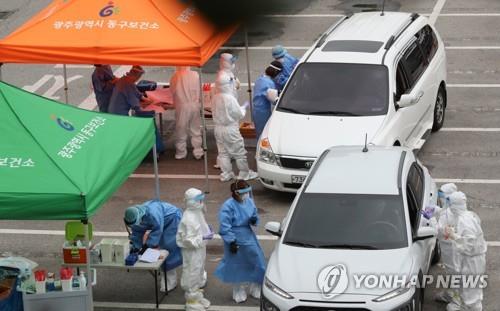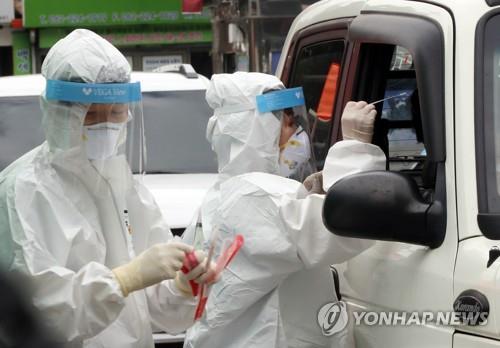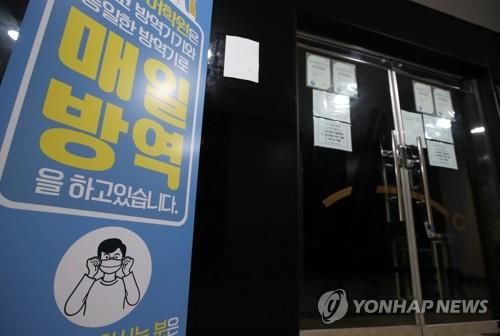- California Assembly OKs highest minimum wage in nation
- S. Korea unveils first graphic cigarette warnings
- US joins with South Korea, Japan in bid to deter North Korea
- LPGA golfer Chun In-gee finally back in action
- S. Korea won’t be top seed in final World Cup qualification round
- US men’s soccer misses 2nd straight Olympics
- US back on track in qualifying with 4-0 win over Guatemala
- High-intensity workout injuries spawn cottage industry
- CDC expands range of Zika mosquitoes into parts of Northeast
- Who knew? ‘The Walking Dead’ is helping families connect
New virus cases tad down, cluster infections in major cities still alarming
South Korea saw its daily new virus cases slightly fall Monday, but a rise in cluster cases in major southern cities, such as Gwangju, as well as imported cases, continued to put a strain on the country’s virus fight.
The country added 48 cases, including 24 local infections, raising the total caseload to 13,139, according to the Korea Centers for Disease Control and Prevention (KCDC).
The tally marked a slight decrease from 61 new cases of COVID-19 reported Sunday, as well as 63 new cases on both Friday and Saturday.



Cars form a line at a drive-thru coronavirus test site in the southwestern city of Gwangju on July 6, 2020. (Yonhap)
Of local infections, seven cases were reported in the southwestern city of Gwangju, followed by six each in Gyeonggi Province surrounding Seoul and the western port city of Incheon. Three cases were reported in Seoul, the KCDC said.
“We ask people take caution as infections at religious facilities or through door-to-door sales continue to increase,” KCDC chief Jeong Eun-kyeong said in a press briefing.
A total of 87 cases have been tied to a Buddhist temple named Gwangneuk in Gwangju as of Monday, up seven from a day earlier. The figure includes cases from a church, also in the city, as the two clusters were found to have connections.
The KCDC said the reproduction rate, or R number, for COVID-19 in southern provinces of Chungcheong and the southwestern Honam region that includes Gwangju was at 1.3 over the past week, higher than the national average of 1.06.
The R number reflects the average number of people infected by a single patient. It is a way of rating a disease’s ability to spread, and a higher figure indicates a greater possibility of more people getting infected.
“Infection risk in the region is the highest,” Jeong said, citing the recent cluster infection tied to Gwangneuk Temple could potentially become a large scale mass infection case.
One more follower of Wangsung Church in Seoul’s southwestern ward of Gwanak was newly confirmed to be infected, bringing the related cases to 36.
One of the hospitals in the central city of Daejeon had a total of 10 patients, up one from the previous day.
Daegu, once the hotbed of the country’s virus outbreak, added no new infections. The city, which accounts for more than half of the country’s COVID-19 cases, recently suffered another uptick in the number of new patients due to group infections from an acting school.
The government of South Jeolla Province, which surrounds Gwangju, said earlier it will raise the region’s social distancing to level 2 from the current level 1, which is equivalent to “distancing in daily life.”
The upgrade calls for tougher virus prevention measures, including banning gatherings of 50 or more people indoors or 100 or more people outdoors, and making it mandatory to wear masks when using public transportation.
A total of 246 schools were closed Monday, with some 180 of them located in Gwangju, according to the education ministry.
All kindergartens, elementary, middle and high schools in Gwangju’s Buk Ward, where an elementary school student has tested positive, will also close for a week, with the exception of high school seniors who are preparing for the year-end college entrance exam.
South Korea has been troubled by rises in sporadic cluster infections in the greater Seoul area since it relaxed strict social distancing on May 6 on the flattened virus curve.
The KCDC said it has not been able to trace infection routes for 75 out of 699 new patients over the past two weeks, or 10.7 percent.
The portion of infections tied to untraceable transmissions exceeded 10 percent on June 15 for the first time since the authorities began counting such data on April 6, the KCDC said.
The country, meanwhile, reported 24 additional imported cases, raising the total of such cases to 1,690. Of the new cases, 15 were detected at quarantine checkpoints.
South Korea has posted a double-digit number of imported cases for 11 consecutive days.
As to a theory that the COVID-19 virus is airborne, local health authorities said more studies should be reviewed.
Earlier in the day, hundreds of scientists said there is evidence showing smaller particles of the virus can infect people in the air, contradicting reports that the coronavirus disease spreads from person to person through small droplets from the nose or mouth.
“More studies should be reviewed for further proof on whether the virus spread is airborne,” Vice Health Minister Kim Ganglip said in a briefing.
South Korea, meanwhile, reported one more death, bringing the death toll to 284. The fatality rate was 2.16 percent.
The total number of people released from quarantine after full recoveries stood at 11,848, up 16 from the previous day.
The country has carried out 1,331,796 tests since Jan. 3.











